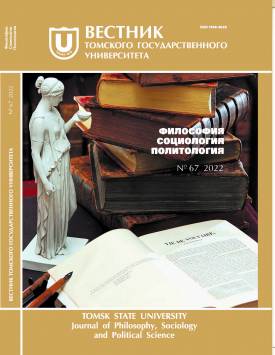The state of the dictatorship of the proletariat or the state of all the people: The state system of the USSR in the Soviet political thought of the Stalin era
The article analyzes aspects of the restructuring of the conceptual framework of the Soviet theory of the state based on the principles of Marxism. This reconceptualization was inspired by Stalin. The purpose was to justify the change in the form of the Soviet state: the proclamation of a “state of all the people” instead of a state of the dictatorship of the proletariat. The principle of the dictatorship of the proletariat could not satisfy the interests of the developing Soviet state, and that is why the concept “people” (the nomination of the actual owner of the state and source of power) and the concept “state of all the people” (the nomination of the new form of the Soviet state) was added to the categorical structure of the Marxist-Leninist theory. To perform this task, the original Marxist principles were subjected to serious adjustment, Soviet political discourse was restructured in accordance with the new guidelines. Since the 1930s, Stalin designed a new Soviet statism and consistently strengthened state-centrism, which required the introduction of specific innovations into the state theory. A theoretical revision of the basic Marxist concepts was needed. The concepts of classes (especially the proletariat), of the dictatorship of the proletariat, and of the state of the dictatorship of the proletariat were revisited. In the Soviet political thought, the significance of a number of Marxist concepts increased (classless society, for example). Other Marxist concepts (“classes”, “class struggle”) lost their meaning. The theory was filled with non-Marxist concepts (“state of all the people”, “truly people’s democracy”, “friendly classes”). The world revolution in rhetoric was pushed into the distant future, and the proletarian party was presented as the party of the whole people. At the same time, the principle of internationalism was not rejected, but reformulated in a new sense - based on the concept of the USSR as the “fatherland of the world proletariat”. The decline in the political importance of classes in general (and of the proletariat in particular) can be seen in Stalin’s works. Stalin methodically accustomed the Soviet public to ideas about changes in the class structure of Soviet society - very significant changes that called into question the existence of classes in the USSR. New principles and concepts were introduced according to the following scheme: Stalin’s inspiration (speeches by Joseph Stalin) - party conceptualization by AUCPB (documents of the party forums) - theoretical design (carried out by scientists and ideologists) - ideological functioning and propaganda support. The author declares no conflicts of interests.
Keywords
dictatorship of proletariat, classless society, Soviet people, 1936 Constitution of USSR, Joseph StalinAuthors
| Name | Organization | |
| Nikandrov Aleksey V. | Lomonosov Moscow State University | bobbio71@mail.ru |
References

The state of the dictatorship of the proletariat or the state of all the people: The state system of the USSR in the Soviet political thought of the Stalin era | Tomsk State University Journal of Philosophy, Sociology and Political Science. 2022. № 67. DOI: 10.17223/1998863X/67/15
